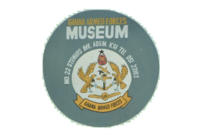
Elmina Castle (St. George’s Castle) – Elmina
The oldest European structure in sub-Saharan Africa, built by the Portuguese in 1482. Major site in the trans-Atlantic slave trade.
Cape Coast Castle – Cape Coast
A large British fort used for slave trading and colonial administration. Now a major museum and historical site.
Fort William – Cape Coast
A hilltop fort that provided defense and lookout; served as a lighthouse in later years.
Fort Victoria – Cape Coast
A smaller watchtower and defensive post built by the British to protect Cape Coast Castle.
Fort McCarthy – Cape Coast
A British military post that supported defense in the Cape Coast area. (No traces left)
Fort Amsterdam – Abandze (near Kormantin)
Originally built by the Dutch, later taken by the British. Active in slave trade operations.
Fort Patience (Fort Lijdzaamheid) – Apam
Built by the Dutch, known for its strong walls and commanding view over Apam harbor.
Fort Good Hope (Goede Hoop) – Senya Beraku
Dutch fort constructed to control trade routes and local trade networks.
Fort Nassau – Moree
One of the earliest Dutch forts on the coast; part of early trading systems.
Fort William (Anomabu) – Anomabu
Different from the Cape Coast fort; part of British fortifications in Anomabu.
British Fort Komenda – Komenda
Built by the British during their rivalry with the Dutch. Used in slave and gold trade.
Dutch Fort Vredenburgh (Komenda) – Komenda
Built by the Dutch on the opposite bank of the river from the British fort. The two forts often exchanged fire.
Fort Metal Cross – Dixcove
British fort used for gold and slave trade. Strategically built to dominate the coastline.
Fort Batenstein – Butre
Dutch fort built on a hill in 1656. Overlooks the village of Butre with panoramic views.
Fort Orange – Sekondi
Dutch, later British. Served as a trading post and later as prison and lighthouse.
Fort San Sebastian – Shama
Built by the Portuguese, later taken by the Dutch and British. Played a role in the trans-Atlantic slave trade.
Fort St. Anthony (Santo Antonio) – Axim
One of the earliest forts, built by the Portuguese and later occupied by the Dutch.
Fort Apollonia – Beyin
British fort on the far west of Ghana’s coast. Supported trade and protected colonial interests.
Fort Gross Friedrichsburg – Princes Town
Built by the Brandenburg-Prussians in the 17th century. Unusual among Ghanaian forts for its German origin.
Fort Dorothea – Akwidaa
A small Prussian fort that supported Fort Friedrichsburg across the coast.
Christiansborg Castle (Osu Castle) – Osu, Accra
Danish-built, later British. Used as Ghana’s seat of government for much of its history. Now a museum.
Ussher Fort (Fort Crèvecœur) – Ussher Town, Accra
Built by the Dutch. Later used as a prison and now a heritage and human rights museum.
James Fort – Jamestown, Accra
British fort from the 17th century. Served as a trading post and later a colonial prison.
Fort Augustaborg – Teshie
Danish fort built in the 18th century. Now in ruins, and hardly to locate. Use locals to guide you. Near an old chief palace.
Fort Fredensborg – Old Ningo
Danish fort used in trade. Abandoned in the late 19th century. Traces to find.
Fort Vernon – Prampram
A lesser-known British fort, used for coastal defense and trade regulation. Near Dutch build 1814 Police Station
Fort Prinzenstein – Keta
Danish-built fort later overtaken by the British. Much of it has been eroded by the sea. So far, there are plans to restore.
Kumasi Fort and Military Museum – Kumasi
Originally built by the Asantehene in 1820, destroyed during the Anglo-Asante war, and rebuilt by the British in 1897. Now a military museum with historical exhibits.